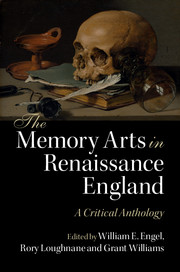Book contents
- Frontmatter
- Dedication
- Contents
- List of figures
- Acknowledgements
- A note on abbreviations
- Introduction
- PART I The art of memory
- PART II Rhetoric and poetics
- PART III Education and science
- PART IV History and philosophy
- Introduction to Part IV
- IV.1 Lodowick Lloyd, The Pilgrimage of Princes (1573)
- IV.2 William Camden, Remains Concerning Britain (1605)
- IV.3 Francis Bacon, The Advancement of Learning (1605)
- IV.4 Pierre Charron, Of Wisdom (1608)
- IV.5 John Weever, Ancient Funeral Monuments (1631)
- IV.6 Edward Reynolds, A Treatise of the Passions and Faculties (1640)
- IV.7 Thomas Fuller, selected works
- IV.8 Kenelm Digby, Two Treatises (1644)
- IV.9 Thomas Hobbes, Leviathan (1651)
- IV.10 William Dugdale, Baronage of England (1675–1676)
- PART V Religion and devotion
- PART VI Literature
- Index
Introduction to Part IV
from PART IV - History and philosophy
Published online by Cambridge University Press: 05 August 2016
- Frontmatter
- Dedication
- Contents
- List of figures
- Acknowledgements
- A note on abbreviations
- Introduction
- PART I The art of memory
- PART II Rhetoric and poetics
- PART III Education and science
- PART IV History and philosophy
- Introduction to Part IV
- IV.1 Lodowick Lloyd, The Pilgrimage of Princes (1573)
- IV.2 William Camden, Remains Concerning Britain (1605)
- IV.3 Francis Bacon, The Advancement of Learning (1605)
- IV.4 Pierre Charron, Of Wisdom (1608)
- IV.5 John Weever, Ancient Funeral Monuments (1631)
- IV.6 Edward Reynolds, A Treatise of the Passions and Faculties (1640)
- IV.7 Thomas Fuller, selected works
- IV.8 Kenelm Digby, Two Treatises (1644)
- IV.9 Thomas Hobbes, Leviathan (1651)
- IV.10 William Dugdale, Baronage of England (1675–1676)
- PART V Religion and devotion
- PART VI Literature
- Index
Summary
What we have come to know as the modern discipline of history resulted from the synthesis of two scholarly methods that emerged in sixteenth-century Europe: humanist learning on the one hand and antiquarianism on the other hand. This division of labour was generally carried out by two separate professions, as Arnaldo Momigliano first famously posited. The historian, who often pursued a career in the civil service, cut and pasted secondary sources together into a narrative account of a bygone era's politics, typically medieval or Renaissance, whereas the antiquary, usually an academic and collector of a more scholarly disposition, tracked down and compiled primary sources about the past, assembling inventories of material artefacts, such as records, coins, epigraphs and ruins. The latter was less concerned with the chronological sequence of events than with systematic description, accurate dating and topographical precision. William Camden (IV.2), for instance, did not view himself as a historian at all, but as an antiquary, calling himself a chorographer, a term taken from geography. Eventually, the two historical methods personified by the respective professions would converge in the work of seventeenth-century virtuosi, gentleman scholars and legal antiquarians, the likes of John Selden, whose Historie of Tithes corroborated what Fussner identified as the ‘historical revolution’.
It should not surprise us that the humanist side to early modern historiography cultivated a rich breeding ground for the memory arts. Daniel Woolf observes with reference to William Caxton, the first English printer, that ‘[r]ight from the beginning of its career in England…history as a printed genre was conceived of as an artificial mnemonic, the vita memoria of Cicero's formulation’. Sixteenth-century humanist historiography, particularly in France, reflected upon the reading and writing of history through a rhetorical outlook. Its genre, the ars historica, privileged narratives about the past that imparted moral conduct and civic lessons to readers, affirming not only De oratore's coupling of history with the service to truth and wisdom, but also De inventione's classification of historia as one of the three types of narration. Lodowick Lloyd's The Pilgrimage of Princes (IV.1) gives one popular variant on the humanist method of history-making by cobbling together commonplaces and exempla, while John Foxe's Acts and Monuments (V.2) conducts a comprehensive historical revisionism on behalf of reformed confession and consolation. Histories remember the past to edify readers ethically.
- Type
- Chapter
- Information
- The Memory Arts in Renaissance EnglandA Critical Anthology, pp. 185 - 190Publisher: Cambridge University PressPrint publication year: 2016

